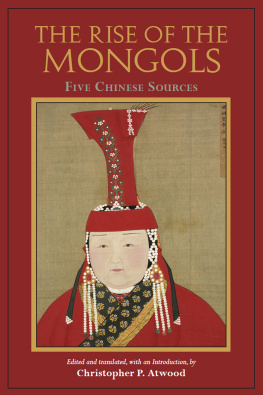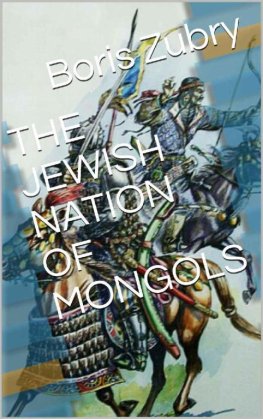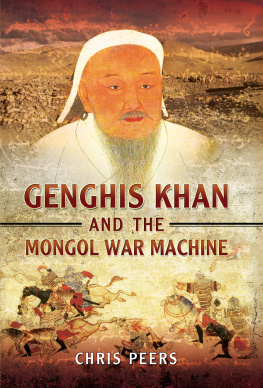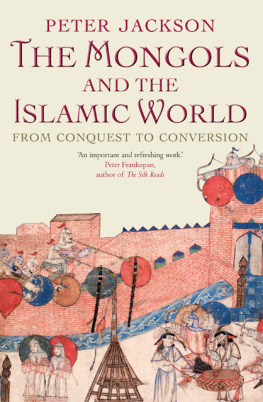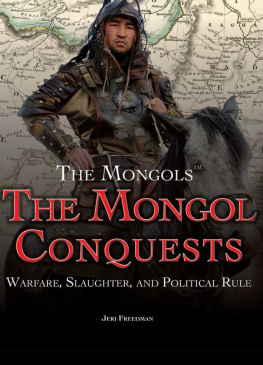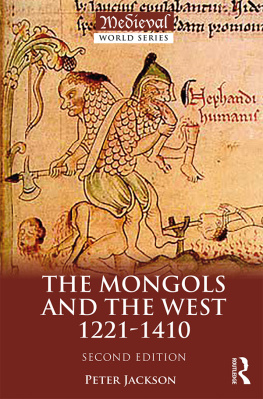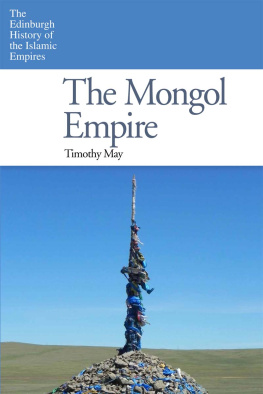Contents
The Rise of the
Mongols
Five Chinese Sources
The Rise of the
Mongols
Five Chinese Sources
Edited and translated, with an Introduction, by
Christopher P. Atwood, with Lynn Struve
Hackett Publishing Company, Inc.
Indianapolis/Cambridge
To students of the Mongol Century, past and future.
Copyright 2021 by Hackett Publishing Company, Inc.
All rights reserved
Printed in the United States of America
24 23 22 21 1 2 3 4 5 6 7
For further information, please address
Hackett Publishing Company, Inc.
P.O. Box 44937
Indianapolis, Indiana 46244-0937
www.hackettpublishing.com
Cover design by E. L. Wilson
Composition by Aptara, Inc.
Cartography by Beehive Mapping, based on work by Wei chen
Library of Congress Control Number: 2021932944
ISBN-13: 978-1-64792-002-9 (cloth)
ISBN-13: 978-1-62466-990-3 (pbk.)
ePub3 ISBN: 978-1-64792-004-3
Kindle ISBN: 978-1-64792-005-0
George Lane, Daily Life in the Mongol Empire .
George Lane, Genghis Khan and Mongol Rule .
Michael Loewe, Everyday Life in Early Imperial China .
The Mission of Friar William of Rubruck: His Journey to the Court of the Great Khan Mngke, 12531255 . Translated by Peter Jackson; Introduction, Notes, and Appendices by Peter Jackson and David Morgan.
Marco Polo, The Description of the World . Translated, with an Introduction and Annotations, by Sharon Kinoshita.
Harold M. Tanner, China: A History, Volume 1: From Neolithic Cultures through the Great Qing Empire .
Contents
The page numbers in curly braces {} correspond to the print edition of this title.
{vii}
The idea behind this book originated in 1999, when I began to teach on the Mongol Empire at Indiana University. My introduction to Mongolian history was as a freshman at Harvard when I took Joseph Fletchers Empire of the Mongols course in the fall of 1982. For that class, Professor Fletcher used no textbook, just primary sources in translation, and I was captivated. Part of the fascination was to see one people and one set of events, the Mongols and their conquests, through so many eyes: Persian, Chinese, Latin Christian, Armenian, as well as the Mongols themselves.
Seventeen years later, when I planned to teach a version of this class myself, I wanted to give students something like the same experience. But since taking Professor Fletchers class, I had learned that there were many valuable, untranslated sources on the Mongol Empire, particularly in Chinese. Some of them were the earliest known descriptions of the new Mongol regime, and for that reason, if no other, they deserved attention. As part of my preparation for teaching, I began to translate several of the works included here, starting with Zhao Gong and his A Memorandum on the Mong-Tatars and continuing with Peng Daya and Xu Tings A Sketch of the Black Tatars and eventually getting to Zhang Dehuis Notes on a Journey. I also began working on the collection of biographies from the Mongols Yuan dynasty, edited by the Chinese scholar Su Tianjue. Included in that collection was the bulk of Song Zizhens Spirit-Path Stele written in honor of the famous scholar and reformer Ila Chucai.
At the time, however, my knowledge of classical Chinese and of the thirteenth-century context was still insufficient. A number of passages taxed my ingenuity. So, I turned to a senior colleague, Lynn Struve, professor of history at Indiana University, who had just completed a classic volume of translations on a similar period of turbulent transition: the seventeenth-century Manchu conquest of Ming China. Lynn had taught me in her Imperial China course, and now she went far beyond the usual demands of mentorship for a young colleague, generously going over every line with suggestions and queries. I took the suggestions and researched the questions as well as I could. Students began using the translations and seemed to be getting something out of them. Their questions and insights began to direct how I taught and understood these texts. Passages from the translations were even occasionally cited in print. For many years, however, I was occupied with other questions and texts. My earlier research had been on the twentieth century in Inner Mongolia, and it took a long time for me to feel that I was really conversant enough with the Mongol Empire to say that I had understood these texts. Meanwhile, I discovered the importance of other texts as well, particularly {viii} Li Xinchuans Random Notes which, written in 1216, constituted the earliest account of the Mongol conquests in any language.
In the summer of 2016, another colleague, Professor Sarah Schneewind at UC, San Diego, asked on the Facebook Sinologists group if anyone had some good readings to represent the Mongol Empire for a class she was planning that fall on Late Imperial China. I forwarded a few of my translations to her and was inspired when she said they deserved to be in print. She also suggested that Hackett Publishing, where she had published her book A Tale of Two Melons , might be interested in them. I was just then relocating to the University of Pennsylvania and, stimulated by her encouragement, decided finally to see about publishing these sources. I approached Hacketts senior editor Rick Todhunter at the Association for Asian Studies Annual Meeting, and we began corresponding in the spring of 2017.
Hackett proved entirely as efficient and encouraging an outfit as Sarah had said it would be. Rick had only one demand, that the relevant parts of Li Xinchuans history, since his was the very first history to treat the Mongol conquests, had to be included. Meanwhile, for an Introduction, I began to write up much of the explanatory material that I had used in my lectures to make sense of these translations. What would students want to know? What would they need to understand to make sense of these Chinese works on the early Mongol Empire? Years of discussion with students have helped me answer these questions.
Completing the Li Xinchuan translation, completing the untranslated parts of Ila Chucais biographical inscription, and getting the long draft translations into shape took a fair amount of time. As I went back to some of the issues Lynn Struve had flagged so long ago, I knew that the newly translated and revised materials could also benefit from her revisions. When I sent them to her, I was deeply grateful that she agreed once again to go over the texts as carefully as if they were her own. The resulting translations would never have been started or brought to completion without her willingness to drop her own multifarious projects on the seventeenth century and assist me in bringing these stories of the thirteenth century to light. Her contribution went far beyond what could be acknowledged in a preface, and I was happy when she agreed to share credit on the title page of our translation. In the introductory material and commentaries that follow, the we refers to Lynn and myself; almost every footnote and every difficult reading was discussed at length between us.
Over the course of two decades, many others have also helped to polish and complete these translations. Particularly helpful in reading through the manuscript and consulting on some of the most difficult puzzles were the two Yuan-era specialists Professor Ma Xiaolin of Nankai University and Dr. Qiu Zhirong; we had known each other in China and I had invited them to come to the University of Pennsylvania as visiting scholars in 20192020. Professor Manling Luo of Indiana University also assisted Lynn on several difficult points. Equally helpful throughout were Hacketts three anonymous readers: Reader A gave many suggestions on the background and Chinese translation; Reader C repeatedly flagged issues which readers without Chinese training might find puzzling; and Reader B {ix} focused on keeping it simple, keeping it consistent, and not overthinking itall important advice though sometimes difficult to follow simultaneously.

